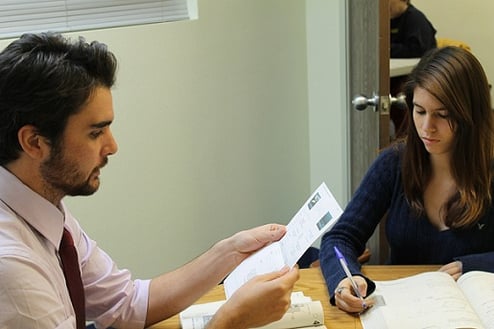
Did you get your PSAT score back and it was lower than you expected? The good news is that PSAT scores aren’t sent to colleges, so your low score will have no impact on your future applications. However, you’ll need to make some changes if you want a higher score when it comes time for you to take the SAT.
This guide will walk you through the steps you need to take to get on the right path, including how to identify what errors you made on the PSAT, how to avoid them on the SAT, and how to develop the best study plan going forward.
Step #1: Self-Study or Tutor?
If you got a PSAT score you’re unhappy with, one of the first major decisions you need to make is to decide whether you want to study for the SAT on your own or with a tutor. If you’re unsure, you don’t need to make this decision right away, but you should keep it in mind as you go through the following steps to decide if hiring a tutor would be helpful in raising your score. We have an entire guide to help you decide if you should use a tutor or self-study, but here’s a brief overview of each option:
Tutor
-
A tutor can help you figure out where you made mistakes and what you should focus on to improve your score in the future.
-
Tutors can be especially helpful for people who:
- Don’t know what they need to improve on.
- Struggle to develop study plans.
-
Have problems staying motivated.
-
A good tutor will work with you to develop a study plan that will target your weaknesses and also work with your schedule.
-
A tutor may also be particularly helpful if you scored much lower than you wanted (200+ points).
-
However, hiring a tutor can be expensive, and not every tutor will be a great fit for you and really help you improve your scores.
Self-Study
-
Self-study doesn’t cost a thing beyond the prep materials you choose to buy, and it lets you have complete control over your study plan.
-
However, self-study can be difficult if you aren’t sure how to fix your mistakes, choose what to study, or think you may have trouble staying motivated.
Think carefully about which option is better for you. If you’d like more information, check out our guide on the pros and cons of each way to test prep.

For some students, having a tutor can help them figure out what they need to focus on while others prefer to develop their own study plans.
Step #2: Analyze Your Mistakes
This is probably the most important step in this guide; without doing this you can spend hours on test prep but not see your scores increase at all. Analyzing your mistakes is critical because, if you don’t understand why you made a certain mistake, you’ll keep repeating it on each test instead of finding the problem and correcting it.
There are four main reasons you may have answered a question incorrectly:
- Content Issue: You were missing fundamental skills or knowledge needed to answer the question (like being asked a question on the volume of a cube but not knowing how to calculate volume).
- Comprehension Issue: You knew the information needed to answer the question, but the wording of the question confused you or was too complicated, so you misread it and answered incorrectly.
- Time Constraint: You knew how to answer the question correctly but didn’t have enough time.
- Careless Mistake: You understood everything perfectly, but you made a silly mistake like filling in the wrong bubble or writing down the wrong number.
In the next section, we’ll go over specific strategies for combating each of these issues. For now, you should take a practice PSAT or SAT, with the sections timed as they would be on the real exam.
After you've finished the test, take a break, then correct the test and find all the questions you answered incorrectly. For each of these questions, you should figure out why you got it wrong. Take a piece of paper, and make four columns on it - one column for each of the reasons listed above. Each time you come to a question you answered incorrectly, put a tally in the appropriate column. When you’re finished, you should be able to easily see what your major reason(s) is/are for getting questions wrong. This may seem like a long and boring step but, trust me, it will save you a ton of time later, and it’s the only way to really make significant improvements in your score.
If you have a tutor, they should guide you through this process, figuring out what your most common mistakes are and how to avoid them.
Khan Academy
Another resource you can use is Khan Academy. In partnership with the College Board, Khan Academy has recently released free SAT prep resources. One part of these resources include the ability to upload your PSAT scores and receive personalized recommendations on what you should study.
You can do this by going to Khan Academy’s website and creating an account if you don’t already have one. Then choose to study SAT skills, and you will be given the option to upload your PSAT scores. This will be done by linking with your College Board account. You’ll be sent to the College Board’s website and asked to give permission to Khan Academy to access your PSAT results. Khan Academy will then use your results to determine which subjects you should focus your studying on.
Be aware that, while this can be a useful and time-saving feature, Khan Academy only detects content errors. It can’t tell if you made a mistake due to time constraints or careless error. It’s only identifying one category of error, so it’s important to follow the above steps to make sure you completely understand what caused you to answer questions incorrectly.

Khan Academy can be a useful way to review your mistakes on the PSAT and develop a plan for your SAT prep.
Step #3: Learn How to Avoid Making the Same Mistakes on the SAT
Now that you’ve figured out what mistakes you made on the PSAT, you need to develop strategies to avoid making those same mistakes in the future. Look at the list you created of your most common causes of error, and use the techniques below to start eliminating these mistakes.
Content Issue
If you made a lot of content errors, that means you have gaps in the knowledge needed to do well on the SAT. You’ll need to identify where these gaps are and work to fill them. Look to see where you answered the most questions incorrectly. Did you do well on the Math section but got tripped up on Reading? Then you should focus more of your study time on Reading.
You should also take this one step further and look more closely within each section. If you got a lot of Reading questions wrong, were they mostly in the scientific passages? On the questions that asked you about the author’s opinion? The more you can narrow down where your content gaps are, the more focused and effective your studying will be.
We have a ton of free guides to help you strengthen your content knowledge. Feel free to browse our blog, or you can get started with these thorough guides on the SAT Math, Reading, and Writing and Language sections.
Comprehension Issue
The SAT is known for being notoriously tricky, and, although the new version of the test is less purposely confusing, it's still easy to get tripped up by what a question is asking, so being fooled by questions is a common mistake. The key to reducing comprehension errors is making sure you understand exactly what each question is asking.
If this is an issue for you, the next time you take a practice exam, read each question twice and underline the key information. This is particularly useful for questions that are long and complicated. A math problem may ask for the solution to 2x, and if you only find x, you may see that value listed among the answer choices and bubble it in, thinking you got the answer correct. Taking a bit more time when reading each question can help reduce errors like these.
We also have a guide specially created to help you eliminate tricky and misleading answer choices and select the correct answer.
Time Constraint
Better time management is needed if you’re missing a lot of questions because you’re crunched for time. One of the best ways to move through test questions faster is to regularly take practice quizzes or full exams, always timing yourself of course. Practicing often will get you more familiar with how questions are worded, and you’ll figure out shortcuts to answer certain problems more quickly.
Also, when you are taking the test, if you’ve stared at a problem for at least 30 seconds and you have no idea how to solve it, skip it and come back to it if you have extra time at the end of the section. Spending a lot of time on a single question and not getting to several other questions as a result is not a good test-taking strategy, and it can really hurt your score.
Finally, try to leave about 5 minutes at the end of each section to look over your answers (doing this during your practice exams will help it become a habit for you). Use these last five minutes to look for any easy questions you haven’t answered yet, and bubble in answers for any questions you skipped.

Running out of time is a common issue on the PSAT and SAT.
Careless Mistake
People make careless mistakes when they aren’t paying enough and/or they’re trying to rush through the exam. The best way to combat this type of mistake is to slow down a bit and really concentrate on the question you’re trying to solve. Rushing through questions just to answer them all won’t help your score if you’re making tons of careless errors.
Like the comprehension issue advice above, you should read each question twice and underline any important words or phrases. For math questions, make sure you know exactly which value you are supposed to solve for, whether it’s x or 3x-5. For Reading and Writing, look out for the words “except” or “not”; it’s likely they’ll change the entire meaning of the question.
Step #4: Start Studying!
Now that you know why you answered questions incorrectly on the PSAT and have strategies to avoid making those same mistakes, it’s time to create a study plan! It’s helpful if you can schedule a regular study time, say Tuesdays, Thursdays, and Sundays from 7-9pm. Knowing in advance when you need to be studying will make it easier for you to schedule other things and remember when you should be doing test prep.
If you’re not sure how to create a study schedule, we have a bunch of guides to help you out. Learn when you should begin studying for the SAT and how long you should study for.
How long you need to study for the SAT will in part depend on how large of a score improvement you’re looking for (check out this guide if you need help converting your PSAT score into an estimate of what you'd get on the SAT). The above guides have more details, but here’s a rough estimate of how much time you should study for the SAT based on how much you want to raise your composite score:
- 0-30 Point Improvement: 10 hours
- 30-70 Point Improvement: 20 hours
- 70-130 Point Improvement: 40 hours
- 130-200 Point Improvement: 80 hours
- 200-330 Point Improvement: 150 hours+
So, clearly, the more you want to improve your score, the more time you’ll need to spend studying. It’s up to you to decide how many hours you want to set aside a week for studying, based on what works best with your schedule.

The more you're looking to increase your score, the more you'll have to study.
Study Resources
You’ll also need to gather the resources you need to study. There’s a huge variety of SAT prep resources available, including prep books and online resources. You may also choose to take a class or hire a tutor. We have guides for the best SAT prep books and SAT websites to help you with your studying.
Your study plan will also definitely include taking some practice tests, and we have links to free and official practice SATs for you to use. Practice tests give you a chance to measure your progress and see where you still need to improve.
Official practice tests are the best to use because you can be sure they are an accurate representation of the actual SAT, so use these tests wisely! Space them out over your study period and take them under conditions as close to the real test as possible. That means taking a complete test in one sitting and with the same timing the real SAT has.
Step #5: Take the SAT
OK, so you’ve identified where you made your mistakes, learned how to prevent them, and spent time studying and taking practice tests. Now it’s time to take the SAT! Ideally, you want a few months between the time you took the PSAT and the time you take the SAT so that you have time to study and improve. SAT test dates in the spring or following fall will probably work best for you.
If you take the SAT and still don’t reach your target score, remember that you can take the SAT multiple times, so you’ll likely have at least one other chance. If you made improvements and just missed your ideal score ( within 50-100 points), you may just need to brush up on your studying a bit more in order to meet your target. It’s not unusual for a person’s scores to vary somewhat from test to test.
If you have made little improvement and/or are still far from your target score, you’ll likely need to change your study methods. Check out our guide to the pros and cons of different study methods to see if something different will work better for you. If you’ve been self-studying so far, you may want to look into getting a tutor or taking an online class.
Summary
Getting a PSAT score lower than you wanted can be disappointing, but, fortunately, a low PSAT score won’t impact your college applications, and there are methods you can follow to avoid making the same mistakes in the future.
Whether you choose to get a tutor or self-study, you’ll need to identify the errors you made on the PSAT and follow strategies to ensure you don’t make those same mistakes on the SAT.
With an organized study plan and regular practice tests to track your progress, you’ll be well on your way to raising your score when it comes time to take the SAT!
What's Next?
Looking for more SAT study tips? Check out these 21 quick study tips to boost your SAT score.
Wondering what SAT score you need to get into your dream school? Setting a target score can be tricky, but our guide will help you easily figure out what SAT score you should be aiming for to get into your top colleges!
Thinking about taking the ACT instead of the SAT? Learn about the differences between the two exams and whether you should take the SAT or the ACT.
Want to improve your SAT score by 160 points? We have the industry's leading SAT prep program. Built by Harvard grads and SAT full scorers, the program learns your strengths and weaknesses through advanced statistics, then customizes your prep program to you so you get the most effective prep possible.
Check out our 5-day free trial today:
Have friends who also need help with test prep? Share this article!

Christine graduated from Michigan State University with degrees in Environmental Biology and Geography and received her Master's from Duke University. In high school she scored in the 99th percentile on the SAT and was named a National Merit Finalist. She has taught English and biology in several countries.


































 Holly R.
Holly R.